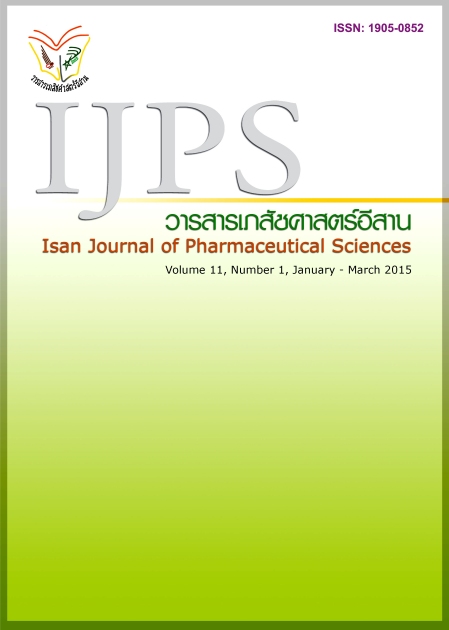Bioequivalence Study of Levocetirizine Dihydrochloride 5 mg Tablets in Healthy Thai Male Volunteers
Main Article Content
Abstract
Levocetirizine, a second generation H1-receptor antagonist, is an (R)-isomer of cetirizine. Due to an extensive use of levocetirizine dihydrochloride in the relief of symptoms associated with seasonal and perennial AR and the treatment of the uncomplicated skin manifestations of CIU, a generic product of levocetirizine dihydrochloride of GPO has been developed with lower price and would be benefit for patients with AR and CIU. Materials and Methods: A randomized, open-label, two-treatment, two-period, two-sequence, single dose, crossover bioequivalence study of the generic levocetirizine dihydrochloride 5 mg tablets of GPO, Thailand and the reference product (Xyzal®) in 26 healthy male subjects, under fasting conditions with 7 days washout period was carried out. Blood samples were collected at predefined time points up to 48 hours. Plasma concentrations of levocetirizine were analyzed using an achiral assay by liquid chromatography tandem mass spectrometry. Non-compartmental model was used for pharmacokinetic analysis. Results: The mean values (±SD) of pharmacokinetic parameters (test vs. reference) were AUC0-tlast (1708.294 ± 372.0046 vs 1739.707 ± 356.0465 hr.ng/mL), AUC0-∞ (1830.174 ± 360.1070 vs 1847.587 ± 344.0151 hr.ng/mL) and Cmax (222.414 ± 37.1886 vs 220.950 ± 36.3423 ng/mL). The 90% Confidence Intervals for the ratios of mean AUC0-tlast , AUC0-∞ and Cmax for the test/reference were 98.1 (94.60-101.72), 99.0 (95.81-102.31) and 100.6 (95.56-105.89), respectively. These values were within the acceptable range of 80.00-125.00. Both the formulations were well tolerated. No clinically significant or serious ADRs were observed. Conclusion: Two formulations of levoceterizine dihydrochloride, GPO and Xyzal®, were bioequivalent and can be used interchangeably.
Article Details
In the case that some parts are used by others The author must Confirm that obtaining permission to use some of the original authors. And must attach evidence That the permission has been included
References
Baltesa E, Coupeza R, Giezeka H et al. Absorption and disposition of levocetirizine, the eutomer of cetirizine, administered alone or as cetirizine to healthy volunteers. Fund din pharmacol 2001; 15: 269-277.
Devalia JL, De Vos C.Hanotte f et al. A randomized, double-blind, crossover comparison among cetirizine, levocetirizine, and ucb 28557 on histamine-induced cutaneous responses in healthy adult volunteers. Allergy 2001; 56: 50-57.
EMA. Guideline on the investigation of bioequivalence. Committee for Medicinal Products for Human Use, EMEA, 2010. [Cited February 2015]. Available from: http://www.ema.europa.eu/docs/en_GB/document_library/Scientific_guideline/2010/01/WC500070039.pdf.
EMA. Guideline on bioanalytical method validation. Committee for Medicinal Products for Human Use, EMEA, 2011. [Cited February 2015]. Available from: http://www.ema.europa.eu/docs/en_GB/document_library/Scientific_guideline/2011/08/WC500109686.pdf.
Food and Drug Administration [FDA], United States. Guidance for industry bioanalytical method validation. US Department of Health and Human Services, FDA, CDER, CVM, 2001 [Cited February 2015]. Available from: http://www.fda.gov/downloads/Drugs/Guidances/ucm070107.pdf.
Gillard M, Perren CVD, Moguilevsky N et al. Binding characteristics of cetirizine and levocetirizine to human H histamine Receptors: contribution of Lys191 and Thr194. Mol Pharmacol 2002; 61: 391-399.
Hair PI and Scott LJ. Levocetirizine - A review of its Use in the management of allergic rhinitis and skin allergies. Drugs 2006;66(7): 973-996
Rani S, Pargal A. Bioequivalence: An overview of statistical concepts. Indian J Pharmacol 2004; 36(4): 209-216.
UCB, Inc., Highlights of prescribing information: Xyzal®(2009).
Wang DY, Hanotte F, De Vos c et al. Effect of cetirizine, levocetirizine, and dextrocetirizine on histamine-induced nasal response เท healthy adult volunteers. Allergy 2001; 56: 339-343.


